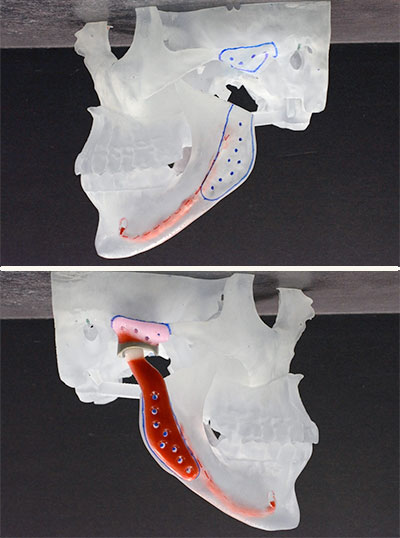Video produced by: UAB Visual Content
For Valerie Accetta, MFA, head of Musical Theatre and assistant professor in the University of Alabama at Birmingham’s Department of Theatre, wear and tear from 15 years of singing, chewing and conversation caused the cartilage in her jaw to completely deteriorate. By spring of 2016, a simple task like eating a slice of pizza was impossible, as her top jaw extended inches over the bottom set of her teeth.
After seeking opinions from dentists from her hometown in Ohio, then in Alabama, Accetta found herself referred to the UAB School of Dentistry and Chung H. Kau, DDS, Ph.D., chair and professor of orthodontics.
 (Top) A model shows Accetta's jaw and the complete absence of her jaw joint. (Bottom) Kau and Louis' teams worked to reconstruct her jaw and restore function to her mouth. “I was blind to the fact that the cartilage in my jaw joint was diminishing; but I started noticing my jaw rotating backward, which caused my smile to have a tremendous overbite,” Accetta said. “It was slowly affecting my career and lifestyle and would have led to the eventual replacement of all of my teeth, as my jaw would not have been able to sustain support for my teeth much longer.”
(Top) A model shows Accetta's jaw and the complete absence of her jaw joint. (Bottom) Kau and Louis' teams worked to reconstruct her jaw and restore function to her mouth. “I was blind to the fact that the cartilage in my jaw joint was diminishing; but I started noticing my jaw rotating backward, which caused my smile to have a tremendous overbite,” Accetta said. “It was slowly affecting my career and lifestyle and would have led to the eventual replacement of all of my teeth, as my jaw would not have been able to sustain support for my teeth much longer.”
In reviewing her case, Kau knew his team had the opportunity to do something special and use state-of-the-art technology to rebuild and reshape Accetta’s jaw and smile structure.
“In a case as severe as Valerie’s, we really treated this like a total joint replacement surgery, not unlike the replacement of a knee or hip, but just in the jaw,” Kau said. “Virtual surgical planning was the best route for optimum care, and we were able to marry customized orthodontics with oral maxillofacial surgery to produce successful results.”
Kau and his team took the lead on planning the surgery, putting the puzzle pieces together in figuring out all the steps needed to complete the reconstruction, from the aesthetic to physiological necessities. This included everything from recommending that she wear lingual braces to straighten her smile before surgery, to taking Accetta’s profession into consideration —knowing she had specific needs as a singer and teacher.
Kau used customized digital planning in orthodontics, real-time jaw tracking with ultrasound technology, and virtual surgical planning to develop a treatment plan that would replace Accetta’s jaw joints. This case was the first time the UAB School of Dentistry had used customized digital planning in orthodontics and real-time jaw tracking with ultrasound technology in a surgery. It was this technology that enabled both UAB School of Dentistry’s orthodontics and oral maxillofacial surgery teams to collaborate on the procedure.
“The real-time jaw tracking was fascinating and critical to our success since it allowed us to study the relationship of Valerie’s jaw and muscles in real-time movement,” Kau said. “From there, we were able to digitally plan exactly where the customized joints would fit in her jaw, a process that helps all involved be as precise as possible before the surgery begins.”
After nearly a year and a half of pre-surgery preparation with Kau, Accetta was ready for the 10-hour surgery that included the actual jaw replacement and sinus reconstruction surgery, all completed by Patrick J. Louis, DDS, M.D., director of UAB’s Department of Oral and Maxillofacial Surgery. Before she went into surgery, Accetta remembers thinking about whether this procedure could in any way impact the quality and depth of her voice as a performer and teacher.
“I felt incredibly supported throughout the entire surgery process, but I had anxiety that any part of the procedure — specifically being intubated for such a long time — could impact my voice and ability to teach and perform,” Accetta said. “The first thing I did when I woke up after the surgery was try to make sound, and once I heard myself, I knew I would be OK.”
Following nearly two months of recovery, Accetta knew the surgery was successful but was not prepared for the changes she experienced in her voice.
“Although I had been a performer for decades, I had no idea how much I had been overcompensating for years as a result of my lack of jaw structure,” Accetta said. “Annunciation, singing, speaking — it all involves so many muscles, and I had really been straining myself day in and day out without even knowing. The surgery not only changed my ability to perform daily tasks but has positively changed my talent and job forever.”